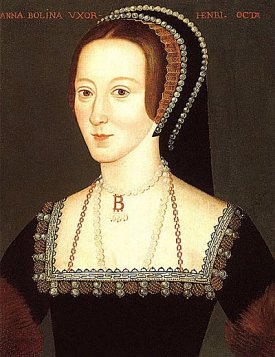Good Queen Jane looked a bit like Mrs. Nunez, my eighth grade algebra teacher. There, I said it. I've been thinking that for nearly ten years now, it's about time someone knows. Everyone says I'm crazy, but if it wasn't seriously uncool, I'd put pictures of them side by side to prove it.
Aside from looking like my eighth grade algebra teacher, Jane was also Henry's favorite queen. Not only was her meek and amiable nature a refreshing change from the tempestuous Anne Boleyn, but she stayed out of politics, and gave him the thing he craved the most, a son.
Where Anne was passionate, witty, and outspoken, Jane was quiet and mild. Like Anne, she had an ambitious family who used her to rise socially; unlike the Boleyns, however, the Seymours were lastingly successful at it. During Edward's minority Jane's brother, Edward Sr., basically ran the country. But where Anne and her family were pushy and obnoxious, Jane and the Seymours were more laid back. They had the benefit of watching the Anne's catastrophic marriage, and Jane definitely learned from her predecessor's mistakes. Her motto as queen--Bound to Obey and Serve-- really says it all. If she had any strong political opinions she kept them to herself.
Jane's tenure as Queen Consort was short, just seventeen months, as opposed to the 24 and 10 years Catherine and Anne had respectively. Arguably, her biggest non-childbearing achievement was reconciling Henry with his eldest daughter Mary. Jane didn't get involved in Henry's affairs much, and she didn't try to push him places he didn't want to go (after Anne's demise, can you blame her?), but on the point of the Princess Mary she remained firm. She pushed for a reconciliation, and she got it, paving the way for Catherine Parr to restore Mary and Elizabeth to the succession.
All in all, Jane's life was very short. She died at only 29 after complications from the birth of her son, Edward. Most historians speculate that she died from puerperal fever, not from a suicidal cesarean section as popular rumor claims. But for such a short lived queen, she had a deep impact on Henry. She was the only queen to be given a queen's funeral, she was painted into family portraits long after her death (even when Henry had remarried), and Henry is buried next to her.
Part One Part Two Part Three Part Four Part Five Part Six Part Seven Part Eight
Sources
Biography.com
The Anne Boleyn Files
| Mrs. Nunez had the same shaped nose, same chin, same sort of eyes. Jane was reportedly a strawberry blond, so that's different, but other than that, they could be twins. |
Aside from looking like my eighth grade algebra teacher, Jane was also Henry's favorite queen. Not only was her meek and amiable nature a refreshing change from the tempestuous Anne Boleyn, but she stayed out of politics, and gave him the thing he craved the most, a son.
Where Anne was passionate, witty, and outspoken, Jane was quiet and mild. Like Anne, she had an ambitious family who used her to rise socially; unlike the Boleyns, however, the Seymours were lastingly successful at it. During Edward's minority Jane's brother, Edward Sr., basically ran the country. But where Anne and her family were pushy and obnoxious, Jane and the Seymours were more laid back. They had the benefit of watching the Anne's catastrophic marriage, and Jane definitely learned from her predecessor's mistakes. Her motto as queen--Bound to Obey and Serve-- really says it all. If she had any strong political opinions she kept them to herself.
 |
| Family portrait of Henry, Edward, and Jane painted after Jane's death |
All in all, Jane's life was very short. She died at only 29 after complications from the birth of her son, Edward. Most historians speculate that she died from puerperal fever, not from a suicidal cesarean section as popular rumor claims. But for such a short lived queen, she had a deep impact on Henry. She was the only queen to be given a queen's funeral, she was painted into family portraits long after her death (even when Henry had remarried), and Henry is buried next to her.
Part One Part Two Part Three Part Four Part Five Part Six Part Seven Part Eight
Biography.com
The Anne Boleyn Files

















